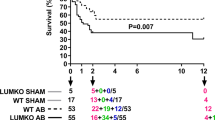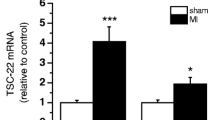Abstract
Recent studies suggest that angiotensin II (angiotensin) may be involved in the regulation of metabolism of the cardiac extracellular matrix (ECM). Two major components of ECM are collagen types I and III which play an important role in maintaining the structure and function of the heart. Although the cellular metabolism of collagen is very complex (especially at the posttranslational level), we chose to address events that occur relatively early in the synthesis of cardiac collagen molecules. To gain an understanding of the role of angiotensin in the regulation of cardiac collagen gene expression, we studied the effect of three different doses of angiotensin (12, 24, and 48 μg/kg/h) on adult heart and cultured neonatal cardiac fibroblasts. The steady-state mRNA abundance of collagen types I and III was monitored using Northern blot analysis in both left and right ventricular samples at day 3 of angiotensin infusion and in cultured cardiac fibroblasts stimulated with angiotensin. In all mRNA abundance studies, glyceraldehyde-3-phosphate dehydrogenase (GAPDH) signal was used to normalize the data for possible differences in loading and/or transfer of total RNA. Both collagen types I/GAPDH and III/GAPDH mRNA signal ratios were increased significantly in left ventricle in all dose regimens used for angiotensin infusion. Only the collagen type I/GAPDH mRNA signal ratio was increased in right ventricle with angiotensin infusion. Angiotensin (10−7-10−5 M) had no effect on the steady-state mRNA abundance of collagen genes in cultured neonatal cardiac fibroblasts after 24 h treatment in serum-free conditions. Our results confirm that infusion of angiotensin may upregulate steady-state collagen gene mRNA abundance in the heart. Angiotensin had no observable effect on collagen mRNA abundance in neonatal fibroblast culture. An explanation for the current results may be that angiotensin causes the release of undefined factors from cardiac myocytes, and that these secondary factors may be involved in either the activation of collagen gene transcription or in alteration of stability of collagen mRNA transcripts via a paracrine mechanism. Although our results indicate hemodynamic loading may potentiate the action of angiotensin, this scenario is unlikely as collagen type I gene expression was increased in the normotensive right ventricle.
Similar content being viewed by others
References
Peach MJ: Renin-angiotensin system: Biochemistry and mechanisms of action. Physiol Rev 57: 313–370, 1977
Baker KM, Campanile CP, Trachte GJ, Peach MJ: Identification and characterization of the rabbit angiotensin II myocardial receptor. Circ Res 54: 286–293, 1984
Pfeffer MA, Braunwald E, Moye LA, Basta L, Brown EJ, Jr. Cuddy TE, Davies BR, Geltman EM, Goldman S, Flaker CC, Klein M, Wertheimer JH, Hawkins CM, on behalf of the SAVE investigators: Effect of captopril on mortality and morbidity in patients with left ventricular dysfunction after myocardial infarction: Results of the survival and ventricular enlargement trial. N Engl J Med 327: 669–677, 1992
Wollert KC, Studer R, von Bulow B, Drexler H: Survival after myocardial infarction in the rat: Role of tissue angiotensin-converting enzyme inhibition. Circulation 90: 2457–2467, 1994
Campbell SE, Janicki JS, Weber KT: Temporal differences in fibroblast proliferation and phenotype expression in response to chronic administration of angiotensin II or aldosterone. J Mol Cell Cardiol 27: 1545–1560, 1995
Weber KT, Sun Y, Tyagi SC, Cleutjens PM: Collagen network of the myocardium: Function, structural remodeling and regulatory mechanisms. J Mol Cell Cardiol 26: 279–292, 1994
Pfeffer JM, Fischer TA, Pfeffer MA: Angiotensin-converting enzyme inhibition and ventricular remodeling after myocardial infarction. Annu Rev Physiol 57: 805–826, 1995
Brilla CG, Zhou G, Matsubara L, Weber KT: Collagen metabolism in cultured adult rat cardiac fibroblasts: response to angiotensin II and aldosterone. J Mol Cell Cardiol 26: 809–820, 1994
Schieffer B, Wirger A, Meybrunn M, Seitz S, Holtz J, Riede UN, Drexler H: Comparative effects of chronic angiotensin-converting enzyme inhibition and angiotensin II type 1 receptor blockade on cardiac remodeling after myocardial infarction in the rat. Circulation 89: 2273–2282, 1994
Alberts B, Bray D, Lewis J, Raff M, Roberts K, Watson JD: Cell junction, cell adhesion, and the extracellular matrix. In: Molecular Biology of the Cell, Garland Publishing, Inc.: NY and London 1994, pp 972–1000
Sadoshima J, Izumo S: Signal transduction pathways of angiotensin II-induced c fos gene expression in cardiac myocytes in vitro. Circ Res 73: 424–438, 1993
Chomczynski P, Sacchi N. Single-step method of RNA isolation by acid guanidiniumthiocyanate-phenol-chloroform extraction. Anal Biochem 162: 156–159, 1987
Kim S, Ohta K, Hamaguchi A, Omura T, Yukimura T, Miura K, Inada Y, Ishimura Y, Chatani F, Iwao H: Angiotensin II type I receptor antagonist inhibits the gene expression of transforming growth factorβ1 and extracellular matrix in cardiac and vascular tissues of hypertension rats. J Pharmacol Exp Ther 273: 509–515, 1995
Villarreal FJ, Dillmann WH: Cardiac hypertrophy-induced changes in mRNA levels for TGF-β1, fibronectin, and collagen. Am J Physiol 262: H1861-H1866, 1992
Bhambi B, Eghbali M: Effect of norepinephrine on myocardial collagen gene expression and response of cardiac fibroblasts after norepinephrine treatment. Am J Pathol 139: 1131–1142, 1991
Omura T, Kim S, Takeuchi K, Iwao H, Takeda T: Transforming growth factor β1 and extracellular matrix gene expression in isoprenaline induced cardiac hypertrophy: Effects of inhibition of the renin-angiotensin system. Cardiovasc Res 28: 1835–1842, 1994
Crawford DC, Chobanian AV, Brecher P: Angiotensin II induces fibronectin expression associated with cardiac fibrosis in the rat. Circ Res 74: 727–739, 1994
Yeowell HN, Murad S, Pinnell SR: Hydralazine differentially increases mRNA for the α and β subunits of prolyl 4-hydroxylase whereas it decreases proα1 (I) collagen mRNAs in human skin fibroblasts. Arch Biochem Biophys 289: 399–404, 1991
Sun Y, Ratajska A, Zhou G, Weber KT: Angiotensin-converting enzyme and myocardial fibrosis in the receiving angiotensin II or aldosterone. J Lab Med 122: 395–403, 1993
Carver W, Nagpal ML, Nachrigal M, Borg TK, Terracio L: Collagen expression in mechanically stimulated cardiac fibroblasts. Circ Res 69: 116–122, 1991
Eghbali M, Tomek R, Sukhatme VP, Woods C, Bhami B: Differential effects of transforming growth factors-β1 and phorbol myristate acetate on cardiac fibroblasts. Circ Res 69: 483–490, 1991
Chua CC, Giglio CA, Siu BB, Chua BHL: Angiotensin II induces TGFβ1 production in rat heart endothelial cells. Biochim Biophys Acta 1223: 141–147, 1994
Gibbons GH, Pratt RE, Dzau VJ: Vascular smooth muscle cell hypertrophy vs. hyperplasia: Autocrine transforming growth factor-β1 expression determines growth response to angiotensin II. J Clin Invest 90:456–461, 1992
Fisher SA, Absher M: Norepinephrine and ANG II stimulate secretion of TGF-β by neonatal rat cardiac fibroblasts in vitro. Am J Physiol 268: C910-C917, 1995
Author information
Authors and Affiliations
Rights and permissions
About this article
Cite this article
Ju, H., Dixon, I.M.C. Effect of angiotensin II on myocardial collagen gene expression. Mol Cell Biochem 163, 231–237 (1996). https://doi.org/10.1007/BF00408663
Issue Date:
DOI: https://doi.org/10.1007/BF00408663




